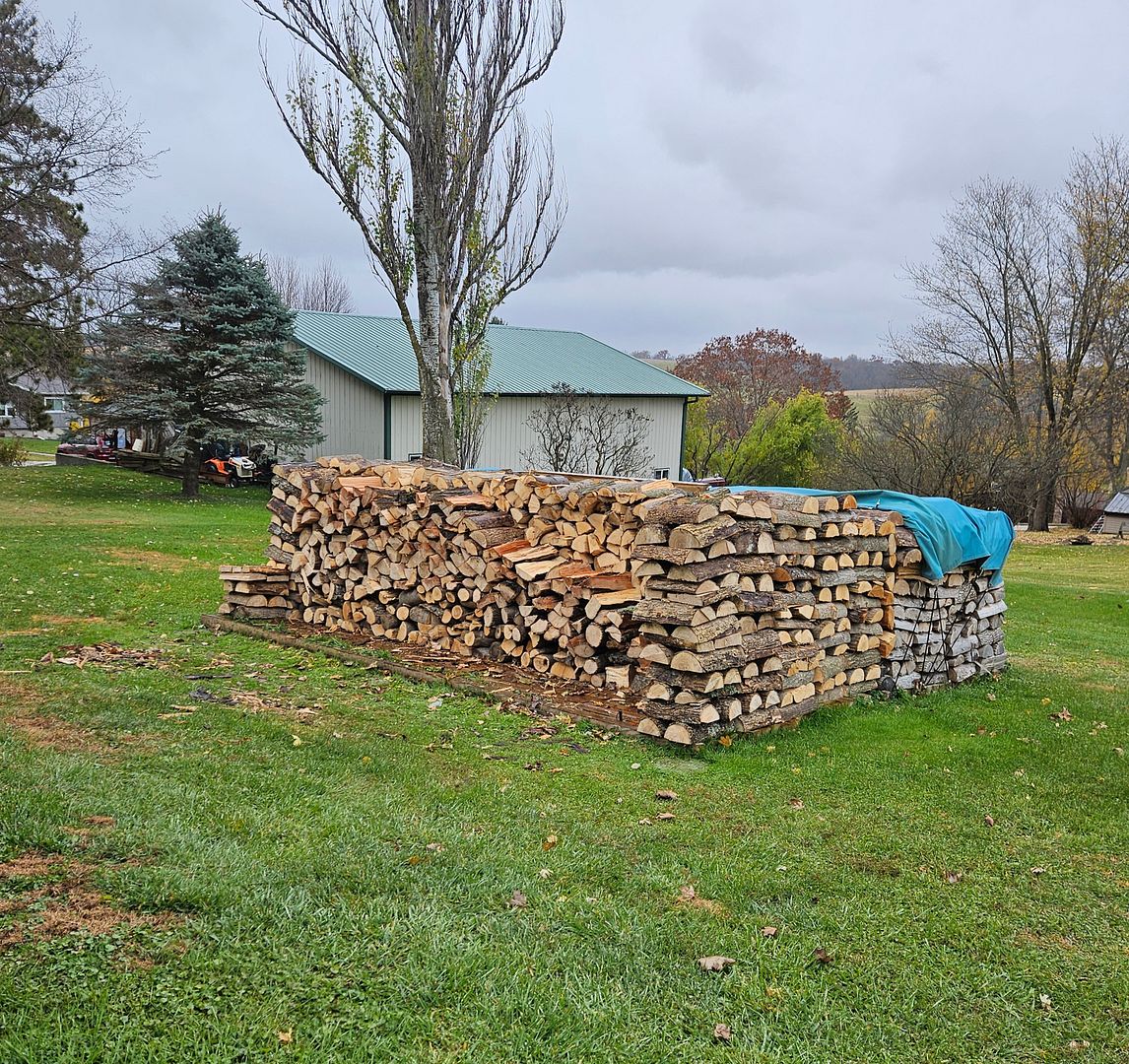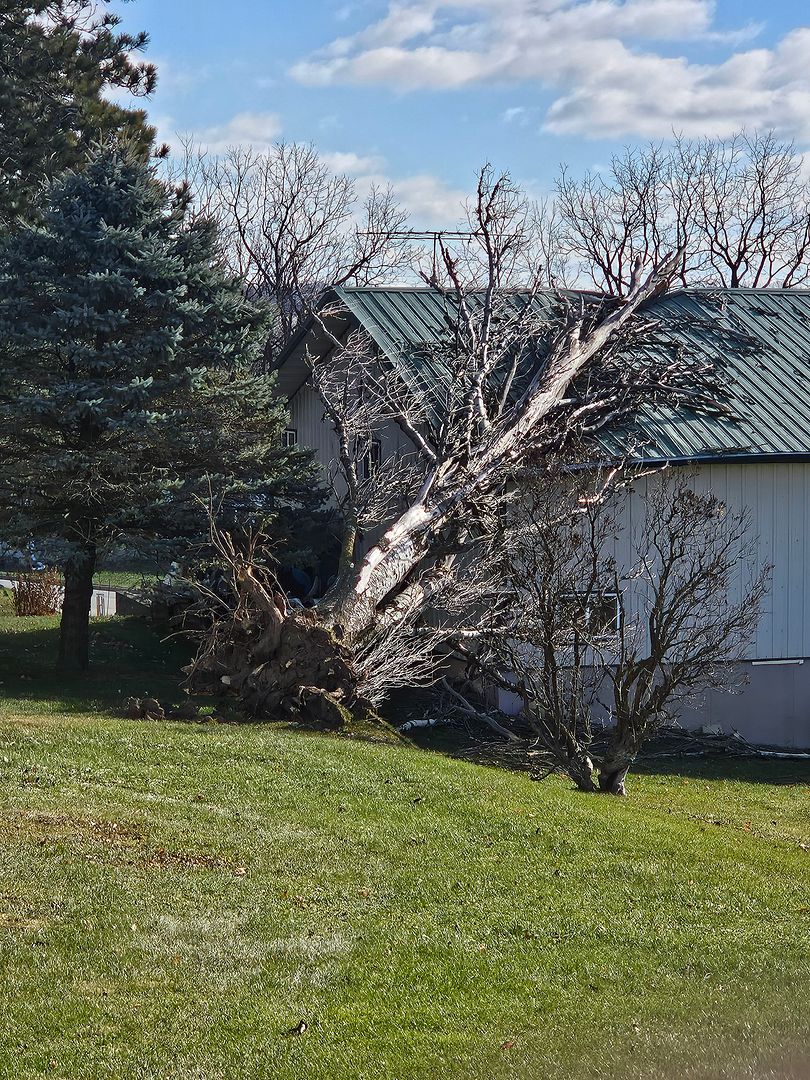- Welcome to FinsandFur.net Forums.
Recent posts
#31
Non Hunting/Fishing Photos / Re: 50 mph winds
Last post by Hawks Feather - November 29, 2025, 07:10:20 AMMore firewood, but I sure hope that is the neighbor's building. 🙏🏻
#32
Non Hunting/Fishing Photos / Re: 50 mph winds
Last post by nastygunz - November 28, 2025, 11:10:33 PMThat had to hurt!. is that your building it landed on ?
#33
Non Hunting/Fishing Photos / 50 mph winds
Last post by FinsnFur - November 28, 2025, 09:02:04 PMWe had 50 mph winds Wednesday night.
As you may be able to tell by some of my yard pics, our village is at the top of one of the rolling hills that the Driftless Region is famous for. So the winds always seem intensified.
I heard something crash like hell Wednesday night in the midst of a window rattling gust. The cat bolted and started looking around the room like God was coming. THAT kinda freaked me out.
I knew nothing hit the house or tore off the house cause as loud as it was, I woulda felt something.
I took a walk outside thinking a tree fell on my truck or maybe the neighbors house. Didnt see nothing and it was pitch black out there.
The next morning I saw this when I opened my blinds.
Remember THAT tree behind the wood pile?



As you may be able to tell by some of my yard pics, our village is at the top of one of the rolling hills that the Driftless Region is famous for. So the winds always seem intensified.
I heard something crash like hell Wednesday night in the midst of a window rattling gust. The cat bolted and started looking around the room like God was coming. THAT kinda freaked me out.

I knew nothing hit the house or tore off the house cause as loud as it was, I woulda felt something.
I took a walk outside thinking a tree fell on my truck or maybe the neighbors house. Didnt see nothing and it was pitch black out there.
The next morning I saw this when I opened my blinds.
Remember THAT tree behind the wood pile?



#34
The Tailgate / Re: Well.. it's about that tim...
Last post by msmith - November 28, 2025, 02:37:58 PMQuote from: FinsnFur on November 26, 2025, 08:37:14 PMI wish you could hear and feel the burning wood crackling in the dining room while I type this.
Man I love it.
That sure would be cozy. My woodburner is outside so I don't get the atmosphere with it.
#35
The Tailgate / Today in history 11-28
Last post by remrogers - November 28, 2025, 11:01:16 AM1925
Nov 28
The Grand Ole Opry begins broadcasting
The Grand Ole Opry, one of the longest-lived and most popular showcases for western music, begins broadcasting live from Nashville, Tennessee on November 28, 1925. The showcase was originally named the Barn Dance, after a Chicago radio program called the National Barn Dance that had begun broadcasting the previous year.
Impressed by the popularity of the Chicago-based National Barn Dance, producers at WSM radio in Nashville decided to create their own version of the show to cater to southern audiences who could not receive the Chicago signal. Both the Grand Ole Opry and the National Barn Dance aired on Saturday nights and featured folk music, fiddling, and the relatively new genre of country-western music. Both shows created a growing audience for a uniquely American style of music and were launching grounds for many of America's most-loved musicians–the singing cowboy Gene Autry got his first big break on the National Barn Dance. The WSM producers recognized that Americans were growing nostalgic for the rural past, so all live performers at the Grand Ole Opry were required to dress in period costumes and adopt old-time names.
The four-and-a-half-hour Grand Ole Opry program became one of the most popular broadcasts in the South, and like its Chicago cousin, helped make country-western an enduring part of the popular American musical landscape.
Nov 28
The Grand Ole Opry begins broadcasting
The Grand Ole Opry, one of the longest-lived and most popular showcases for western music, begins broadcasting live from Nashville, Tennessee on November 28, 1925. The showcase was originally named the Barn Dance, after a Chicago radio program called the National Barn Dance that had begun broadcasting the previous year.
Impressed by the popularity of the Chicago-based National Barn Dance, producers at WSM radio in Nashville decided to create their own version of the show to cater to southern audiences who could not receive the Chicago signal. Both the Grand Ole Opry and the National Barn Dance aired on Saturday nights and featured folk music, fiddling, and the relatively new genre of country-western music. Both shows created a growing audience for a uniquely American style of music and were launching grounds for many of America's most-loved musicians–the singing cowboy Gene Autry got his first big break on the National Barn Dance. The WSM producers recognized that Americans were growing nostalgic for the rural past, so all live performers at the Grand Ole Opry were required to dress in period costumes and adopt old-time names.
The four-and-a-half-hour Grand Ole Opry program became one of the most popular broadcasts in the South, and like its Chicago cousin, helped make country-western an enduring part of the popular American musical landscape.
#36
The Tailgate / Re: Well.. it's about that tim...
Last post by Hawks Feather - November 27, 2025, 03:22:40 PMWhen I look at that stacking, I believe that Jim was a mechanical engineer in a former life.
#37
The Tailgate / Re: Have a Wonderful Thanksgiv...
Last post by remrogers - November 27, 2025, 12:11:43 PMEveryone stay safe and enjoy the day.
#38
The Tailgate / Today in history 11-27
Last post by remrogers - November 27, 2025, 12:09:05 PM1703
Nov 27
Freak storm dissipates over England
On November 27, 1703, an unusual storm system finally dissipates over England after wreaking havoc on the country for nearly two weeks. Featuring hurricane strength winds, the storm killed somewhere between 10,000 and 30,000 people. Hundreds of Royal Navy ships were lost to the storm, the worst in Britain's history.
The unusual weather began on November 14 as strong winds from the Atlantic Ocean battered the south of Britain and Wales. Many homes and other buildings were damaged by the pounding winds, but the hurricane-like storm only began doing serious damage on November 26. With winds estimated at over 80 miles per hour, bricks were blown from some buildings and embedded in others. Wood beams, separated from buildings, flew through the air and killed hundreds across the south of the country. Towns such as Plymouth, Hull, Cowes, Portsmouth and Bristol were devastated.
However, the death toll really mounted when 300 Royal Navy ships anchored off the country's southern coast—with 8,000 sailors on board—were lost. The Eddystone Lighthouse, built on a rock outcropping 14 miles from Plymouth, was felled by the storm. All of its residents, including its designer, Henry Winstanley, were killed. Huge waves on the Thames River sent water six feet higher than ever before recorded near London. More than 5,000 homes along the river were destroyed.
The author Daniel Defoe, who would later enjoy worldwide acclaim for the novel Robinson Crusoe, witnessed the storm, which he described as an "Army of Terror in its furious March." His first book, The Storm, was published the following year.
Nov 27
Freak storm dissipates over England
On November 27, 1703, an unusual storm system finally dissipates over England after wreaking havoc on the country for nearly two weeks. Featuring hurricane strength winds, the storm killed somewhere between 10,000 and 30,000 people. Hundreds of Royal Navy ships were lost to the storm, the worst in Britain's history.
The unusual weather began on November 14 as strong winds from the Atlantic Ocean battered the south of Britain and Wales. Many homes and other buildings were damaged by the pounding winds, but the hurricane-like storm only began doing serious damage on November 26. With winds estimated at over 80 miles per hour, bricks were blown from some buildings and embedded in others. Wood beams, separated from buildings, flew through the air and killed hundreds across the south of the country. Towns such as Plymouth, Hull, Cowes, Portsmouth and Bristol were devastated.
However, the death toll really mounted when 300 Royal Navy ships anchored off the country's southern coast—with 8,000 sailors on board—were lost. The Eddystone Lighthouse, built on a rock outcropping 14 miles from Plymouth, was felled by the storm. All of its residents, including its designer, Henry Winstanley, were killed. Huge waves on the Thames River sent water six feet higher than ever before recorded near London. More than 5,000 homes along the river were destroyed.
The author Daniel Defoe, who would later enjoy worldwide acclaim for the novel Robinson Crusoe, witnessed the storm, which he described as an "Army of Terror in its furious March." His first book, The Storm, was published the following year.
#39
The Tailgate / Re: Have a Wonderful Thanksgiv...
Last post by Hawks Feather - November 27, 2025, 11:41:11 AMHappy Thanksgiving to all. My wife and I will be enjoying Thanksgiving together and then meeting the kids and grandkids on Saturday. One daughter's divorce was just finalized and the X gets the kids today and tomorrow. {After being married to my daughter for 22 years, he decided he is gay 🦨.}
#40
The Tailgate / Re: Have a Wonderful Thanksgiv...
Last post by FinsnFur - November 27, 2025, 08:35:53 AMYep Happy Thanksgiving to each and everyone of you. 
Life isnt always fair, but there will always be many things to be thankful for, to those willing to recognize it.

Life isnt always fair, but there will always be many things to be thankful for, to those willing to recognize it.

